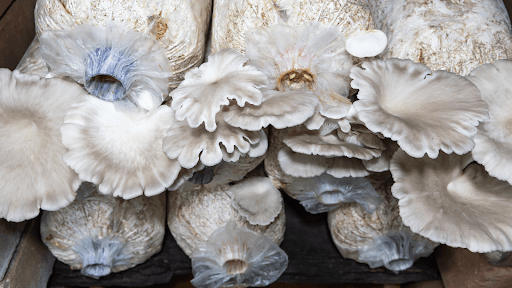Maybe you’re a mushroom lover on a budget. Perhaps you’re a greenthumb looking for the next challenge. Or maybe you’re an entrepreneur looking to explore if your next enterprise should be in the booming mushroom industry.
The fact is, regardless of why or on what scale you want to grow mushrooms, there are some things you should know before getting started.
Here are our tips for growing mushrooms.
Start Small
If you’ve never tried to grow mushrooms before, we recommend you start by following the KISS rule: keep it simple, stupid.
The simplest way is to purchase a pre-made mushroom grow kit or log from a local — or if you have to, online —mushroom business. Kits are made of supplemented sawdust and usually come with instructions. Basically, you just cut a slit in the bag, mist a few times a day, and watch as your mushrooms grow. Oftentimes, you can get multiple harvests — called flushes — from one kit, meaning you get some solid bang for your buck, too.
With logs, it’s even easier, though you’ll have to be much more patient. With pre-inoculated logs, you just put them in a shady, preferably moist area on your property, and wait a few months or up to a year. Once they fruit, you harvest. This fruit and harvest cycle can repeat itself multiple times over multiple years.
Set a Boundary
Before you dive too deep into the mycological rabbit hole, it’s a good idea to decide and write down how much time per week you want to devote to this hobby. If you don’t, you’ll likely make the classic novice mushroom grower mistake: getting excited, starting a process with gusto, then quickly becoming overwhelmed by the amount of work you’ve just created for yourself over the next month(s).
It’s also a good idea to write down your goals. Are you looking to just grow a couple pounds per month, or enough to consistently feed your family? Are you trying to stock your medicine cabinet full of tinctures, or create surplus to sell at a local farmer’s market?
With a clear goal in mind, you can then see if your hours per week limit can even meet them.
Set Aside a Space
Different parts of the mushroom life cycle require different spaces for growth. In the earliest stages (petri dishes), they demand a sterile workspace, or a laboratory. In the vegetative (aka colonization) growth stage, they require a warm, semi-dark room. And in the fruiting stage, they need temperate temperatures, — each species is a bit different – high humidity, and lots of fresh air.
Once you have a clear idea of your goals, you can figure out what space you need. The most important thing to know in all of this is that when fruiting mushrooms, especially oyster mushrooms, it is imperative that you have a space to exhaust out the billions of spores being released from the mushroom. If it’s one bag, it’s not a big deal. But if you’re fruiting multiple bags, beware. There’s a condition called mushroom lung —caused by the inhalation of mushroom spores — and it is not something to be messed around with.
Be Humble
A big part of mushroom cultivation is failure. If you can’t handle failure, this probably isn’t a good hobby for you. But failure is how you learn, and so long as you learn, it’s less failure than a great learning experience. Remaining humble and expecting failure to occur makes those moments when it does much easier to handle. Remember, this is a journey, not a race.
And most importantly, we think, is to remember to have fun! For most people, this is supposed to be a fun hobby, not a chore. If it ever starts to feel like work, check back in on those boundaries and goals you set and see where you have gone awry.
Now go out and grow something!

